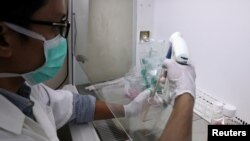Malaysia’s last rhinoceros, Iman, died last November. Some skin, eggs and tissue are all that remain of her.
Now, scientists plan to use experimental technology to try to bring back Malaysia’s rhinos by using cells from Iman and two other dead rhinos.
Muhammad Lokman Md Isa is a biologist at the International Islamic University of Malaysia. He said, “If everything...works well and everybody supports us, it’s not impossible.”
Malaysia’s rhinos were a kind of Sumatran rhinoceros, the smallest among the world’s rhinos. These rhinos once lived across Asia. But hunting and forest losses reduced their numbers.
There are about 80 such rhinos left in Indonesia. But, in Malaysia, the species disappeared from the wild in 2015.
Iman was 25 when she died at her home in a protected natural area on Borneo island. Tam, the country’s last male rhino, died there in May of 2019.
Efforts to get the two to mate and produce young had failed.
John Payne of the Borneo Rhino Alliance has worked to save Malaysia’s rhinos for about 40 years. He said that Tam was likely too old to produce good sperm.
“To increase the chances of success, one should get sperm and eggs from the rhinos in Indonesia,” he said. But, Payne said Indonesia is not supportive of the idea.
Indonesia’s environment ministry says talks continue on ways to work with conservationists in the neighboring Malaysia.
The Malaysian scientists plan to use cells from the dead rhinos to create an embryo. The embryo will then be placed into a living rhino, or a closely related animal, such as the horse.
The plan is similar to one for the African northern white rhinoceros, of which there are only just two left. Researchers in that effort reported some success in 2018 in producing embryonic stem cells for the southern white rhino.
But the process is still far from producing a whole new animal, say Thomas Hildebrandt and Cesare Galli, the scientists leading the research.
Even if it worked, the animals’ lack of diversity could create a threat to their long-term survival, Galli told Reuters.
Indonesian scientist Arief Boediono is among those helping in Malaysia. Arief hopes that success there will help his country’s rhinos.
“It may take five, 10, 20 years, I don’t know,” Arief said. “But there has already been some success involving lab rats in Japan, so that means there is a chance.”
Japanese researchers have grown teeth and even organs with embryonic stem cells from rats and mice. The end goal of that research is to create replacement organs for humans who need them.
For now, however, Iman’s skin will be used to create a reproduction of the animal. It will be placed alongside a reproduction of Tam in a Borneo museum.
I'm John Russell.
Joseph Sipalan reported on this story for Reuters. John Russell adapted it for Learning English. Caty Weaver was the editor.
_____________________________________________________________
Words in This Story
biologist – n. a scientist who studies the life processes of animals, plants etc.
species – n. a particular group of living things that belong together or have some shared quality
sperm – n. a cell that is produced by the male sexual organs and that combines with the female's egg in reproduction
stem cell – n. a simple cell in the body that is able to develop into any one of various kinds of cells (such as blood cells, skin cells, etc.)
diversity – n. the condition of having or being composed of differing elements
museum – n. a building in which interesting and valuable things (such as paintings and sculptures or scientific or historical objects) are collected and shown to the public








